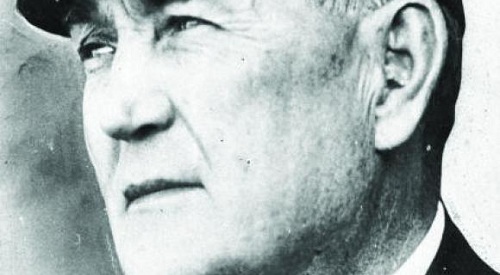
Celebrating baseball’s very distant past
As one of the first orders of business handled at the Baseball Winter Meetings in Nashville last week, the National Baseball Hall of Fame held a special press conference to announce its three newest inductees, chosen from a panel of Pre-Integration Era nominees: player Jim “Deacon” White, umpire Hank O’Day, and owner Jacob Ruppert.
The first question posed to the press conference panel was awesomely blunt.
To paraphrase:
White played pro ball from 1871-1890; O’Day umpired from 1895-1927 (with the exception of the 1912 and 1914 seasons, in which he managed the Cincinnati Reds and then the Chicago Cubs); and Ruppert owned the Yankees from 1915-1939. The Hall has been inducting members ever since 1936. If White, O’Day and Ruppert were not considered worthy of Hall of Fame honor at any prior time in the last three-quarters of a century; why are they now suddenly deserving of enshrinement?
It’s an excellent question, and one that has been bandied about concerning quite a few players over the years. Ralph Kiner and Bruce Sutter were elected in their 13th year of eligibility on the ballot and it took both Bill Terry and Bert Blyleven 14 go-rounds to hear their names called. In all four accounts, some more than others, that long wait chafed a lot of folks, both for and against the candidates. James Laurie “Deacon” White of Caton, NY, received just one vote in the inaugural 1936 election. 76 years later, he’s going into the Hall of Fame.
How can this happen? Did his statistics change? Did he become a better player somehow in the last 10 years?
[php snippet=1]
Not quite. The passing of time brings the wisdom of perspective. Advanced metrics revealed that Bert Blyleven was a far more exceptional pitcher than what was originally thought. Likewise, research vindicated Jim White’s greatness.
As told to the questioner at the press conference: White was the superstar of his day, a barehanded catcher extraordinaire who dwarfed the majority of his peers. In the context of his age, he was every inch a baseball icon, both offensively and defensively in a career that featured remarkable longevity. Meanwhile, Hank O’Day was one of the giants of his trade at the most difficult time in baseball’s history to be an umpire and was honored with the task of calling the very first World Series. He ended up arbitrating in 10 Fall Classics total, the second-highest mark for any umpire in the game’s history. Lastly, Colonel Jake Ruppert, a four-term New York congressman, took over a laughingstock Yankee franchise and, on the shoulders of Babe Ruth, Lou Gehrig and a host of Hall of Fame talents, presided over New York’s first seven World Championship teams.
The question therefore is not “why are these three men suddenly going into the Baseball Hall of Fame now?” but “why in the world did it take 76 years to give them their just dues?”
Instead of blaming all of the Hall of Fame’s panels up to this year, I’d rather give credit where it’s due. After the press conference, I overheard one member of the Hall of Fame voting panel saying how proud he was of his fellow panelists for their research had made his job so easy to determine the proper honorees.
Esteemed historian Peter Morris, for example, conducted an exhaustive study into the evolution of the catching position for his book, “Catcher.” The book finishes with an afterword titled “The Man the Hall of Fame Forgot,” detailing the final decades in the great Jim White’s life and his profound disappointment at being ignored in the Hall’s 1939 Old Timers’ panel vote on the stars of the 19th century. He died in July, only a few months after the newest inductees were announced in the preceding January. Morris wrote in summary: “Yet while White’s absence from Cooperstown is a great injustice, it makes sense in a curious way. He was the greatest catcher of an era when the feats of catchers were so incomparable that they could not be incorporated into the game’s history.”
Now Deacon White and his exploits will no longer be obscured. The same holds true for Hank O’Day, once a pitcher, then an umpire, briefly a manager, and finally a scout, who spent more than 40 years as a part of the National League. With O’Day’s inclusion, there are now an even 10 umpires honored by the Baseball Hall of Fame; only a John McGraw or an Earl Weaver would think that number is too high. Lastly, Col. Ruppert, who erected Yankee Stadium and oversaw the founding of sports’s great dynasty, will be remembered for his contributions to the game.
There is a movement that argues, a little persuasively, that White, O’Day and Ruppert are long since departed. Who has even heard of them these days? Besides, what glory is there in honoring them when we can instead honor the greats who are still with us? After all, posthumous plaudits pale when placed in comparison with honoring the living.
I do not see why these two ideas need to battle one another.
We most certainly should pay homage to the greats while they are still with us, letting them know how much we appreciate for all that they gave to the game. (This was the great sadness of Ron Santo’s passing and posthumous induction.)
But the Baseball Hall of Fame exists for all of us, not just the inductees; it is a museum, not just a private club. As such, the Hall of Fame should not forget the finest players, umpires, and executives in the national pastime’s long, storied history, overcoming any omissions or exclusions. White, O’Day, and Ruppert were giants in their day and rightful Hall of Famers now.
With this in mind, we should applaud the members of the Pre-Integration Era panel and celebrate the induction of such a worthy trio.
[php snippet=1]

